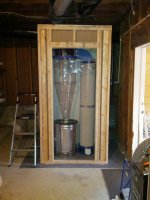Hi everybody,
I'm not quite done with my installation yet, but here is an in-progress photo.
The enclosure lives in a storage space behind my garage. My shop is in the garage, through the door on the right of the photo.
I built a standalone enclosure out of 2x4s using standard platform framing, sitting on a sheet of rubber just to protect it from any moisture in the concrete floor. I used a double top plate to square it up, so the total height is 97.5" before the ceiling/lid. I sheetrocked the inside with 5/8" gypsum. The interior dimensions after sheetrocking are 28 x 41.25".
Since taking the picture, I used Roxul Safe N Sound mineral wool batts to insulate the walls, and then hung sheetrock on the exterior back and sides. The front is going to be 5/8" plywood, with a simple door made of 5/8" plywood over a 2x4 frame, filled with Roxul.
The ceiling/lid is going to be a similar construction to the door: 5/8" plywood over a 2x4 frame filled with Roxul. The point is that the lid needs to be removable if I ever need to get to the motor.
I mounted two 2x4s on the interior that are level (which is not parallel to the floor, in this case!) and then used two more 2x4 cross pieces to make a rectangular frame to hold the cyclone mount. I added some strips of 1/2" plywood to keep things in place once I knew where I wanted it.
The intake is going to be cut through the right side; I'm going to use flexible duct just to get through the wall of the garage, to help isolate vibrations. The exhaust is going to be through a cutout in the lid over the motor, and then through many feet of flexible HVAC, which will then return to the shop. I'm hoping that this will be sufficient airflow to keep the motor from overheating.
Anyway, this whole thing was motivated by a desire to isolate the noise, which is why I'm posting here. Obviously it's too soon to tell how well it works, since the enclosure isn't finished. But already I can say that the low frequency noise does not travel upstairs; I think this is because the enclosure does not touch the frame of the house. I'm optimistic that the whole thing will be quite effective once I finish the door and lid.
I'll keep you posted!
-JS3
I'm not quite done with my installation yet, but here is an in-progress photo.
The enclosure lives in a storage space behind my garage. My shop is in the garage, through the door on the right of the photo.
I built a standalone enclosure out of 2x4s using standard platform framing, sitting on a sheet of rubber just to protect it from any moisture in the concrete floor. I used a double top plate to square it up, so the total height is 97.5" before the ceiling/lid. I sheetrocked the inside with 5/8" gypsum. The interior dimensions after sheetrocking are 28 x 41.25".
Since taking the picture, I used Roxul Safe N Sound mineral wool batts to insulate the walls, and then hung sheetrock on the exterior back and sides. The front is going to be 5/8" plywood, with a simple door made of 5/8" plywood over a 2x4 frame, filled with Roxul.
The ceiling/lid is going to be a similar construction to the door: 5/8" plywood over a 2x4 frame filled with Roxul. The point is that the lid needs to be removable if I ever need to get to the motor.
I mounted two 2x4s on the interior that are level (which is not parallel to the floor, in this case!) and then used two more 2x4 cross pieces to make a rectangular frame to hold the cyclone mount. I added some strips of 1/2" plywood to keep things in place once I knew where I wanted it.
The intake is going to be cut through the right side; I'm going to use flexible duct just to get through the wall of the garage, to help isolate vibrations. The exhaust is going to be through a cutout in the lid over the motor, and then through many feet of flexible HVAC, which will then return to the shop. I'm hoping that this will be sufficient airflow to keep the motor from overheating.
Anyway, this whole thing was motivated by a desire to isolate the noise, which is why I'm posting here. Obviously it's too soon to tell how well it works, since the enclosure isn't finished. But already I can say that the low frequency noise does not travel upstairs; I think this is because the enclosure does not touch the frame of the house. I'm optimistic that the whole thing will be quite effective once I finish the door and lid.
I'll keep you posted!
-JS3

